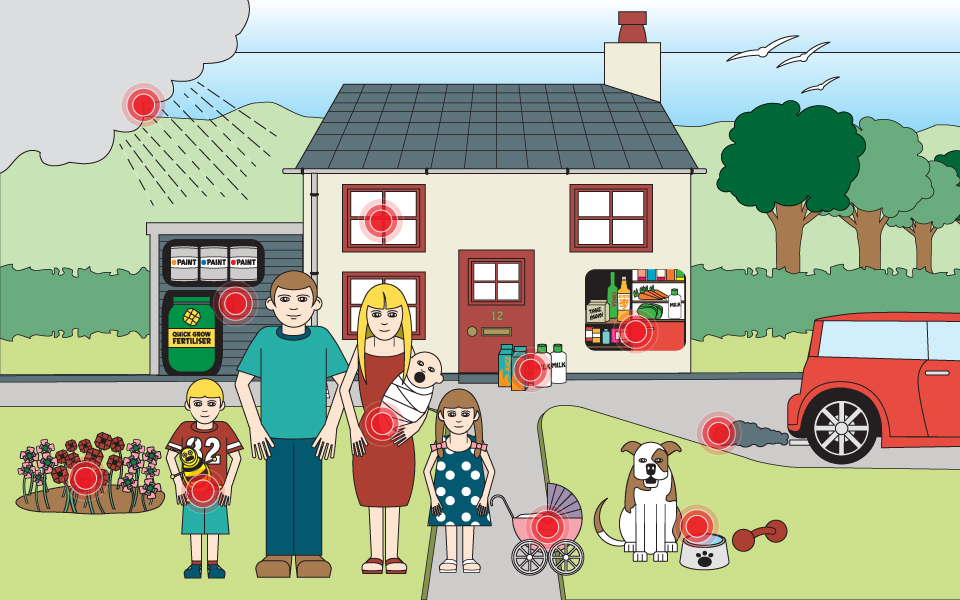
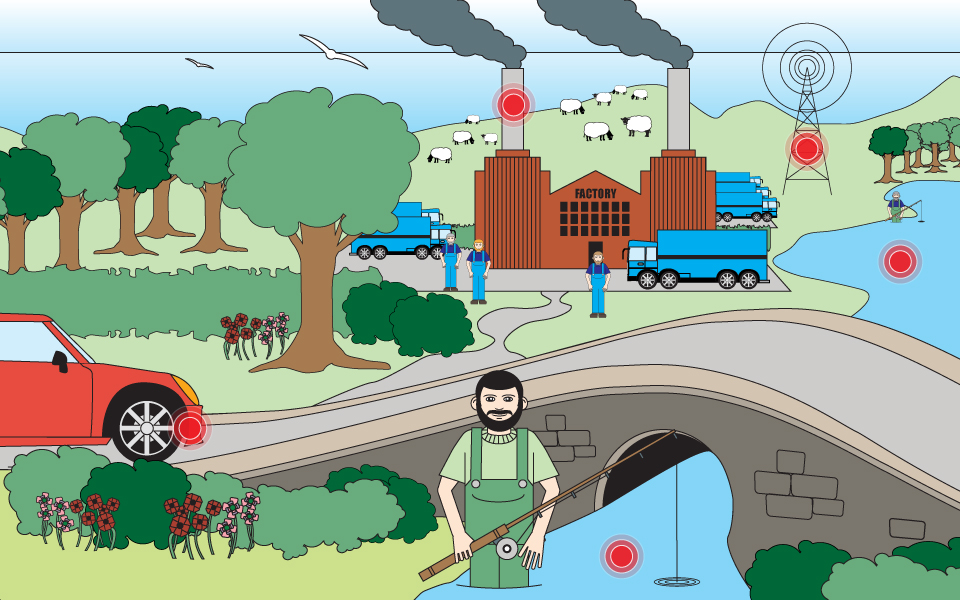
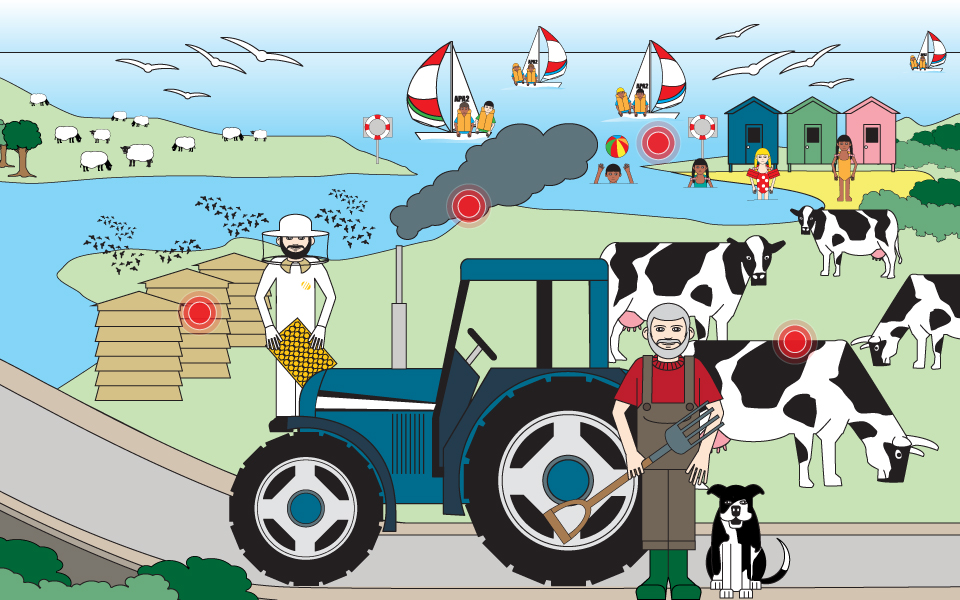
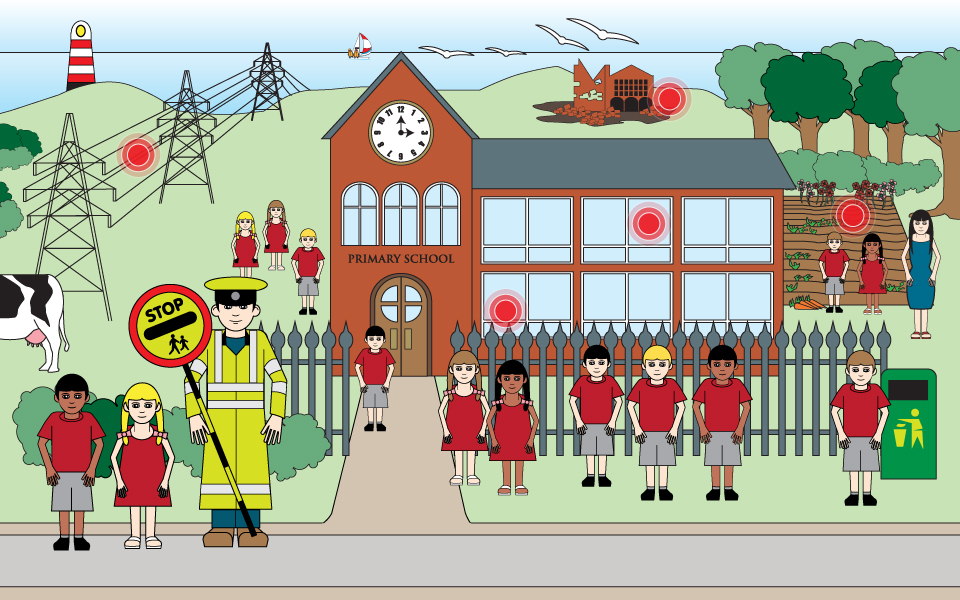
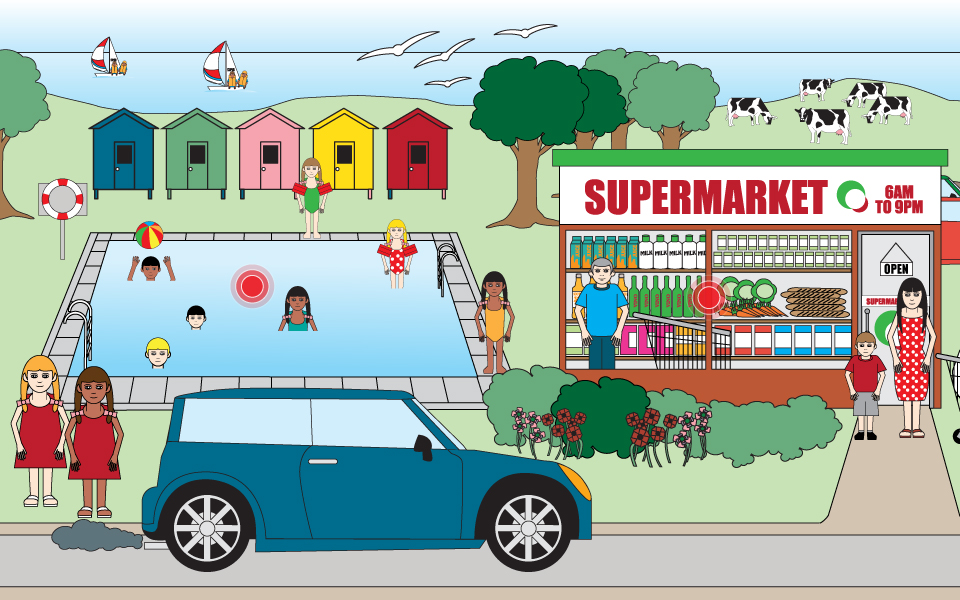
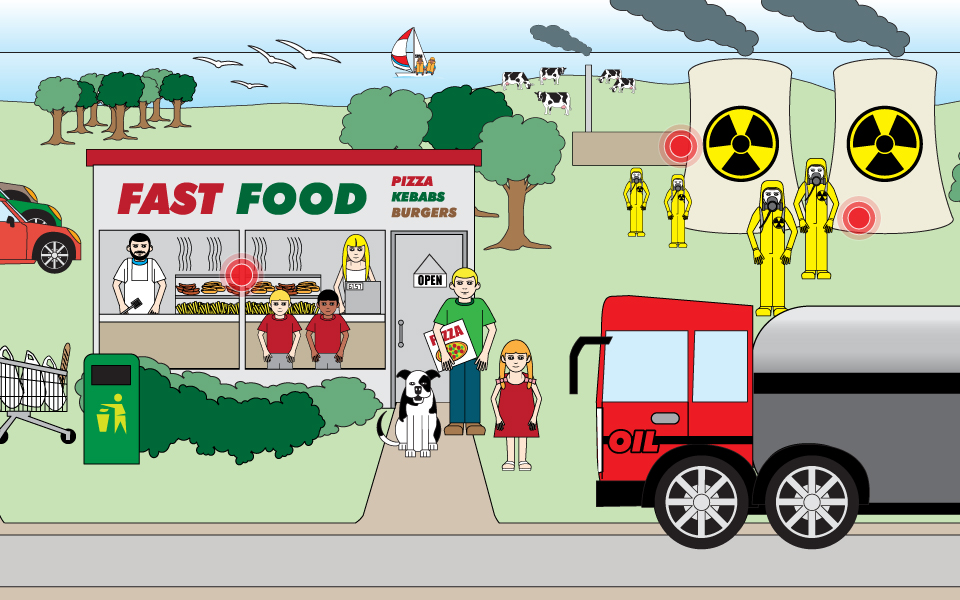
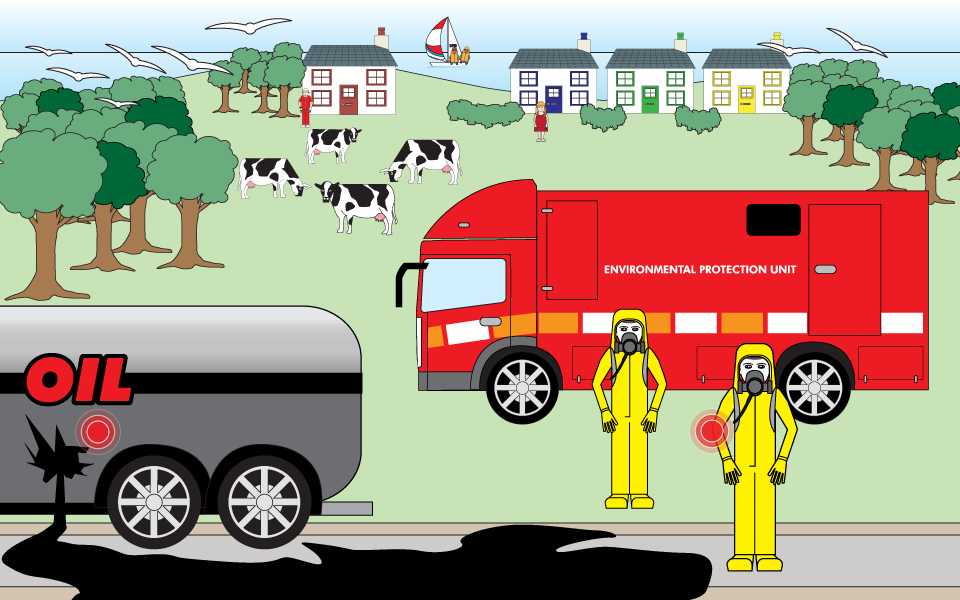
Emergency Response Collaboration
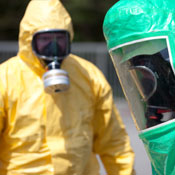
Scientific staff from many of the Public Analyst laboratories assist the fire service in responding to chemical incidents, major fires, white powder events or potential terrorist attack. Using a range of Detection, Identification and Monitoring equipment, the scientists advise the officer in charge.
Radiation Monitoring
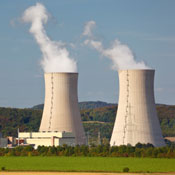
Low levels of radioactivity from industrial sources, such as the nuclear industry, is monitored in food, water, air and other environmental sources. Sensitive radiation monitoring equipment is used by laboratory staff on site, for example responding to an incident with the emergency services. This information is used in safe systems of work and to protect emergency service staff and the public.
Consumer products - food contamination / complaints
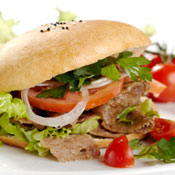
Contamination - Food is analysed for the presence of contamination, such as extraneous matter, heavy metals, pesticides and toxins.
Complaints - Members of the public can submit food complaints to their local environmental health office for investigation. These samples will be passed to the labs for investiagtion. It’s really like food forensics and requires a high degree of investigative work and analysis.
Food Poisoning - Whether this is caused due to spoilage of the food, or due to porr hygiene or cross contamination, the labs carry out micribiological examination and chemical analysis to ensure that the food is safe to eat. Where an outbreak has been identified, the labs work closely with environmental health, the National Health Service and the Food Standards Agency to investigate the source of the outbreak.
Consumer products - food quality

Quality - nutritional testing is carried out to compare with food labels and legislative limits such as minimum meat content. Foods are tested for freshness and to ensure there are no harmful bacteria or toxins.
Substitution - Branded products, such as Scotch Whisky, Gin and Vodka are subjected to detailed analysis to ensure that the contents are genuine, and in the case of spirits, there is no added water. Meat products are checked to ensure the meat species matches the name of the food. Milk is checked for the presence of added water.
Read MoreAdditives - Levels of additives such as flavour enhancers, artificial colours and preservatives are subject to legislatove limits. The labs carry out analysis on the food products to ensure these additives are within the legal limits, and are permitted in the first place. Allergens - An increasing number of consumers can react to the presence of certain ingredients, such as peanuts, shellfish, dairy products or gluten from wheat products. Food labelling is used to alert the consumer if certain ingredients are present and the labs carry our analysis of the foods to check that these claims can be justied.
Swimming pool water testing

Pool waters and spa pools are tested on a regular basis to ensure bather safety and that the water has the correct concentration of chemicals to protect the plant and building materials. Legionella testing is carried out in showers and air conditioning systems.
Read MoreTopsoil

Contaminated land assessments are carried out, for example when a brown field site is being developed or a school is importing top soil for their garden growing area.
Indoor air quality

Whether it is someone concerned about their working environment (sick building syndrome) or health concerns in the home, the labs can assist with monitoring the indoor air quality using a range of on site and lab based techniques.
School - meals testing

Food Poisoning - Whether this is caused due to spoilage of the food, or due to porr hygiene or cross contamination, the labs carry out micribiological examination and chemical analysis to ensure that the food is safe to eat. Where an outbreak has been identified, the labs work closely with environmental health, the National Health Service and the Food Standards Agency to investigate the source of the outbreak.
Brown field site development
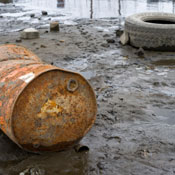
Contaminated land assessments are carried out, for example when a brown field site is being developed or a school is importing top soil for their garden growing area.
Radon Gas

Radon is a natural radioactive gas. You cannot see, hear, feel or taste it. It comes from the minute amounts of uranium that occur naturally in all rocks and soils. Radon is present in all parts of the UK, although the gas disperses outdoors so levels are generally very low. Surveys of homes and businesses can be carried out and the results compared to national safety guidelines.
Coastal water quality
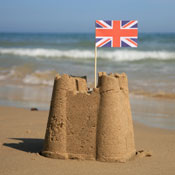
Surface waters such as lochs and rivers are checked for pollution. This is to protect fish stocks and to ensure that recreation use of the water bodies can be carried out safely. Coastal bathing waters are tested for quality and the presence of sewage contamination.
Read MoreRelated links SEPA Environment Agency HSE - Legionnaires Disease
Vehicle emissions
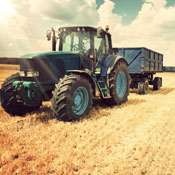
The APA labs have thousands of monitoring points across the UK, measuring harmful emissions from vehicles and industrial sources. The results are reported to the enforcement authority and are available on a national database.
Read MoreAnimal Feed

As well as ensuring the human food chain is safe, public analysts also act as agricultural analysts, checking that feeds supplied to farm and pet animals are safe and meets standards laid down in The Agriculture Act 1970. Pet food is formulated specifically for certain animals and good quality pet foods can be expensive. Consumers therefore expect that the food will fulfil their pet’s dietary requirements and keep their pet healthy.
Honey testing
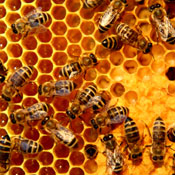
Honey is the sweet product produced by bees from the nectar of flowers and has been enjoyed as a luxury food for thousands of years. Public analysts test honeys to ensure they are authentic and meet legal standards. Honeys have been found to be adulterated or substituted with cheap sugar syrups. The country of origin of the honey and the varieties of flowers that the honey has been produced from can also be determined by analysis of the pollen in the honey.
Read MorePublic analysts can also test the honey for residues of antibiotics that may have been used to treat bees and can also check whether any of the pollen in the honey comes from genetically modified plants. Honey can be produced from different plants in different parts of the world, with some honeys being clear and pale in colour, others being dark and set, all having differing aromas and tastes. Medicinal properties have also been attributed to some honeys, such as Manuka honey from New Zealand.
Surface water - rivers
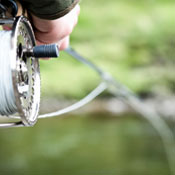
Surface waters such as lochs and rivers are checked for pollution. This is to protect fish stocks and to ensure that recreation use of the water bodies can be carried out safely. Coastal bathing waters are tested for quality and the presence of sewage contamination.
Read MoreSurface water - rivers

Surface waters such as lochs and rivers are checked for pollution. This is to protect fish stocks and to ensure that recreation use of the water bodies can be carried out safely. Coastal bathing waters are tested for quality and the presence of sewage contamination.
Read MoreMobile phone transmitter radiation
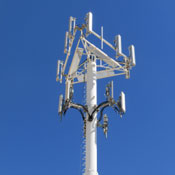
Site surveys of non ionising radiation from mobile phone transmitters or electric pylons is carried out and the results are compared to national safety guidelines. These measurements are made in real time and performed over the surrounding area, including sensitive receptors such as schools and homes.
Industrial emissions
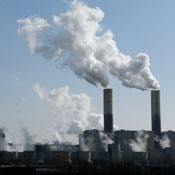
The APA labs have thousands of monitoring points across the UK, measuring harmful emissions from vehicles and industrial sources. The results are reported to the enforcement authority and are available on a national database.
Read MoreCar emissions 3
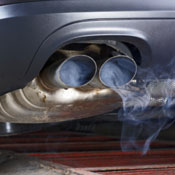
The APA labs have thousands of monitoring points across the UK, measuring harmful emissions from vehicles and industrial sources. The results are reported to the enforcement authority and are available on a national database.
Related links
Related links
DEFRA - Local Air Quality Management Support
Car emissions

The APA labs have thousands of monitoring points across the UK, measuring harmful emissions from vehicles and industrial sources. The results are reported to the enforcement authority and are available on a national database.
Related links
Car emissions 1

The APA labs have thousands of monitoring points across the UK, measuring harmful emissions from vehicles and industrial sources. The results are reported to the enforcement authority and are available on a national database.
Read MoreConsumer products (pet food)
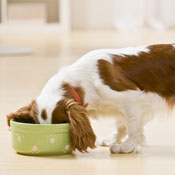
As well as ensuring the human food chain is safe, public analysts also act as agricultural analysts, checking that feeds supplied to farm and pet animals are safe and meets standards laid down in The Agriculture Act 1970. Pet food is formulated specifically for certain animals and good quality pet foods can be expensive. Consumers therefore expect that the food will fulfil their pet’s dietary requirements and keep their pet healthy.
Read MoreAgricultural analysts test pet food for nutrients such as protein, oil and fibre, as well as for vitamins and minerals. Many pet foods make special health claims, e.g. dog food for hip and joint health, and analysts check that these claims are accurate and that the food does actually have the claimed effect. Pet foods have also been prone to adulteration and contamination in recent years. Many dogs and cats died in the USA in 2007 when pet food was adulterated with melamine as a substitute for protein, which these animals are unable to digest. Pet foods are therefore tested for contaminants such as heavy metals, e.g. lead, mycotoxins (toxins found in mouldy food) and industrial contaminants such as dioxins.
Consumer products (baby milk)
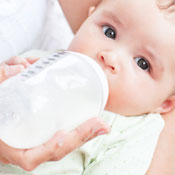
Milk formula and food for infants and young children is strictly controlled by law in the UK and EU to ensure that it is safe to consume and that it is of good nutritional quality. Babies and young children require a carefully balanced diet incorporating sufficient protein, vitamins and minerals to ensure healthy growth and development. They are also more susceptible to contaminants in their food than older children and adults.
Read MorePublic analysts test infant formula and baby food for nutritional content and check the amounts of vitamins and minerals that they contain to ensure they comply with standards. Tests are also carried out for contaminants such as heavy metals, mycotoxins (toxins found in mouldy food), pesticide residues and harmful process contaminants. In recent years, adulteration of infant milk with melamine has led to illness and even death in babies and young children in China. Melamine has been found in the UK in foods containing milk imported from China and public analysts have been involved in developing testing for this adulterant.
Consumer products (children’s toys / children’s clothing)

Public Analysts test consumer products to determine whether goods are safe. We do this at the request of Trading Standards officers and private companies.
The tests we do are guided by British and European legislation and standards and we are often asked to present evidence in court cases as expert witnesses.
Read MoreWe frequently check the safety of toys to ensure they meet the requirements of the European toy safety standard EN 71. The prescribed tests include:-
- mechanical and physical properties such as small parts which may be a choking hazard, sharp edges, sharp points, and resistance to damage caused by normal use.
- flammability, that is the burning characteristics of the toy.
- migration of metals, that is the content of metals, lead, cadmium, arsenic and others, which may be present in the materials used in or on the toy that are toxic to children.
- hazardous chemicals, such as primary aromatic amines and colouring matter, whose use is either restricted or absolutely prohibited.
- Assessment of the safety of experimental sets and chemical toys.
- Microbiological quality assessments.
- Labelling checks to ensure that toys are used by children of the appropriate age and that the correct warnings are present.
Consumer products (children’s toys / children’s clothing)

Public Analysts test consumer products to determine whether goods are safe. We do this at the request of Trading Standards officers and private companies.
The tests we do are guided by British and European legislation and standards and we are often asked to present evidence in court cases as expert witnesses.
Read MoreWe frequently check the safety of toys to ensure they meet the requirements of the European toy safety standard EN 71. The prescribed tests include:-
- mechanical and physical properties such as small parts which may be a choking hazard, sharp edges, sharp points, and resistance to damage caused by normal use.
- flammability, that is the burning characteristics of the toy.
- migration of metals, that is the content of metals, lead, cadmium, arsenic and others, which may be present in the materials used in or on the toy that are toxic to children.
- hazardous chemicals, such as primary aromatic amines and colouring matter, whose use is either restricted or absolutely prohibited.
- Assessment of the safety of experimental sets and chemical toys.
- Microbiological quality assessments.
- Labelling checks to ensure that toys are used by children of the appropriate age and that the correct warnings are present.
Soil analysis

Chemical analysis, bacteriological examination and radiation assessment of soil from a wide variety of sources such as decommissioned industrial sites. Examination of soil to assess the nutritional quality for growing plants and crops. Follow up to pollution incidents, including groundwater analysis.
Consumer products (milk / dairy)
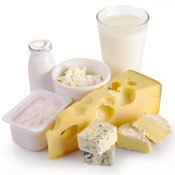
Dairy products such as milk, cream, cheese and yoghurt are consumed by millions of people every day. Public analysts test these foods to ensure that they are safe, of good quality and compliant with UK and EU legislation.
Read MoreChecks are carried out on the amount of fat in milk and cream to ensure that the descriptions skimmed and semi-skimmed milk or single and double cream are accurate. Tests can also show if milk has been watered down or if it contains residues of antibiotics. Tests on cheese can determine whether they are accurately described, e.g. Cheddar cheese must not contain more than 39% water. Yogurts described as ‘Low Fat’ must not contain more than 3% fat. Analysis of proteins and DNA in dairy products can be used to test for different species, e.g. whether a cheese is made with cow’s or goat’s milk and can even differentiate between Mozzarella cheese made with cow’s milk or buffalo’s milk. A significant amount of fraud has been perpetrated in this area in recent years and these tests ensure that consumers are not being misled about the nature or origin of the foods they are purchasing. In recent years, adulteration of infant milk with melamine has led to illness and even death in babies and young children in China. Melamine has been found in the UK in foods containing milk imported from China and public analysts have been involved in developing testing for this adulterant.
Consumer products (kitchen) / drinking water
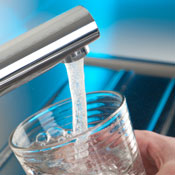
Drinking Water
Whether the water is taken from a consumer’s tap, a private water supply, office water cooler or mineral water borehole, the APA laboratories carry out extensive chemical analysis and bactriological examination to ensure the water passes strict legilsative limits. The labs can also carry out source identification, for example to trace the source of water found collecting in someone’s house or garden.
Read MoreRelated links The Drinking Water Inspectorate Private Water Supplies
Consumer products (bathroom)

Cosmetic products are subjected to safety assessments and to make sure they comply with legislation. For example toothpaste for fluoride content, heavy metals in make up and the peroxide content of teeth whiteners.
Consumer products (garage)

Motor vehicle fuel is tested for compliance with the legal standard. Complaint samples are checked for water and particulate matter contamination and to make sure they are not contaminated with another fuel type. Paint is checked for heavy metals that are toxic, such as lead. Domestic fertilisers are analysed to check the nutrient levels against the declaration on the label for compliance with legislation. The active ingredients of weed killers are measured to make sure they are safe to use, effective and packaged and labelled properly.
Air Pollution Monitoring

Public Analyst laboratories measure the quality of ambient air on behalf of local authorities in order to ensure that that the air that we breath meets required standards in relation to the concentration of a range of pollutants such as:-
• Dust and particulates
• Heavy metals including lead,
• Nitrogen oxides (NOx) and sulphur dioxides
• Volatile organic compounds (VOCs) such as benzene, toluene and xylene (BTX) and chlorinated hydrocarbons
• Radioisotopes including radon
• Fibres, including asbestos.
Laboratories also monitor indoor air quality for a similar range of pollutants which include:- • Odours • Dusts • Microbiological air quality • Combustion gases On a similar theme laboratories also monitor exhaust ventilation systems to ensure effective safe use in schools and other institutions:- • Testing of local exhaust ventilation units and fume cupboards

